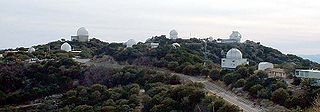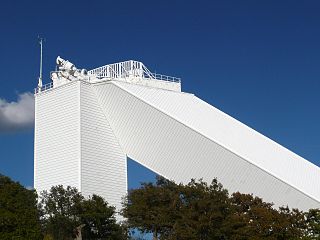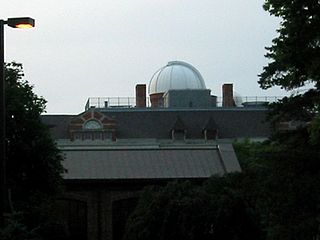
The Kitt Peak National Observatory (KPNO) is a United States astronomical observatory located on Kitt Peak of the Quinlan Mountains in the Arizona-Sonoran Desert on the Tohono Oʼodham Nation, 88 kilometers (55 mi) west-southwest of Tucson, Arizona. With more than twenty optical and two radio telescopes, it is one of the largest gatherings of astronomical instruments in the Earth's northern hemisphere.

Lowell Observatory is an astronomical observatory in Flagstaff, Arizona, United States. Lowell Observatory was established in 1894, placing it among the oldest observatories in the United States, and was designated a National Historic Landmark in 1965. In 2011, the Observatory was named one of "The World's 100 Most Important Places" by Time Magazine. It was at the Lowell Observatory that the dwarf planet Pluto was discovered in 1930 by Clyde Tombaugh.

Yerkes Observatory is an astronomical observatory located in Williams Bay, Wisconsin, United States. The observatory was operated by the University of Chicago Department of Astronomy and Astrophysics from its founding in 1897 to 2020. Ownership was transferred to the non-profit Yerkes Future Foundation (YFF) in May 2020, which began restoration and renovation of the historic building and grounds. Re-opening for public tours and programming began May 27, 2022.
Astrophysics is a science that employs the methods and principles of physics and chemistry in the study of astronomical objects and phenomena. As one of the founders of the discipline said, Astrophysics "seeks to ascertain the nature of the heavenly bodies, rather than their positions or motions in space–what they are, rather than where they are." Among the subjects studied are the Sun, other stars, galaxies, extrasolar planets, the interstellar medium and the cosmic microwave background. Emissions from these objects are examined across all parts of the electromagnetic spectrum, and the properties examined include luminosity, density, temperature, and chemical composition. Because astrophysics is a very broad subject, astrophysicists apply concepts and methods from many disciplines of physics, including classical mechanics, electromagnetism, statistical mechanics, thermodynamics, quantum mechanics, relativity, nuclear and particle physics, and atomic and molecular physics.

McDonald Observatory is an astronomical observatory located near the unincorporated community of Fort Davis in Jeff Davis County, Texas, United States. The facility is located on Mount Locke in the Davis Mountains of West Texas, with additional facilities on Mount Fowlkes, approximately 1.3 kilometers (0.81 mi) to the northeast. The observatory is part of The University of Texas at Austin. It is an organized research unit of the College of Natural Sciences.

Heber Doust Curtis was an American astronomer. He participated in 11 expeditions for the study of solar eclipses, and, as an advocate and theorist that additional galaxies existed outside of the Milky Way, was involved in the 1920 Shapley–Curtis Debate concerning the size and galactic structure of the universe.
Robert Raynolds McMath was a U.S. solar astronomer.

McMath–Pierce solar telescope is a 1.6 m f/54 reflecting solar telescope at Kitt Peak National Observatory in Arizona, United States. Built in 1962, the building was designed by American architect Myron Goldsmith and Bangladeshi-American structural engineer Fazlur Rahman Khan. It was the largest solar telescope and the largest unobstructed aperture optical telescope in the world. It is named after the astronomers Robert Raynolds McMath and Keith Pierce.

Angell Hall Observatory is an astronomical observatory owned and operated by University of Michigan. It is located on the UM Central Campus on top of Angell Hall in Ann Arbor, Michigan (US). It has a computer-controlled 0.4-m Cassegrain telescope in its single dome, and a small radio telescope on the roof. In the past it has housed a large, clock-driven refracting telescope and a reflecting telescope in side-by-side domes. The current telescope was manufactured by DFM Engineering and installed in December 1994.

A solar telescope is a special purpose telescope used to observe the Sun. Solar telescopes usually detect light with wavelengths in, or not far outside, the visible spectrum. Obsolete names for Sun telescopes include heliograph and photoheliograph.

Francis Charles McMath was an American civil engineer and amateur astronomer.
1955 McMath, provisional designation 1963 SR, is a stony Koronis asteroid from the outer region of the asteroid belt, approximately 10 kilometers in diameter.

The Detroit Observatory is located on the corner of Observatory and Ann streets in Ann Arbor, Michigan. It was built in 1854, and was the first scientific research facility at the University of Michigan and one of the oldest observatories of its type in the nation. It was designated a Michigan State Historic Site in 1958 and placed on the National Register of Historic Places in 1973.
Leopold Goldberg was an American astronomer who held professorships at Harvard and the University of Michigan and the directorships of several major observatories. He was president of both the International Astronomical Union and the American Astronomical Society. His research focused on solar physics and the application of atomic physics to astronomy, and he led many of the early efforts to study the Sun from space telescopes.

The Peach Mountain Observatory (PMO) is an astronomical observatory owned and operated by the University of Michigan (UM). It is located near the village of Dexter, Michigan (USA), about 20 kilometers (12 mi) northwest of Ann Arbor. It was opened in 1955, and is used for research, instruction, and amateur observing.
The Portage Lake Observatory (PLO) was an astronomical observatory owned and operated by the University of Michigan (UM). It was located near the village of Dexter, Michigan (USA), about 20 kilometers (12 mi) northwest of Ann Arbor. Construction at the site began in 1948, and the facility was closed in 1975.

Sherzer Observatory is an astronomical observatory located on the campus of Eastern Michigan University. The observatory was established in 1903 with the construction of the new Natural Science Building, in Ypsilanti, Michigan. Following a devastating fire in 1989 a new observatory opened in September 1991 with a 10-inch (250 mm) apochromatic refractor telescope and German equatorial mount centered under a 6-meter dome.

Helen Dodson Prince was an American astronomer who pioneered work in solar flares at the University of Michigan.
Emma Ruth Hedeman was an American solar astronomer at McMath-Hulbert Solar Observatory in Michigan.













